2019-第十二讲19c.英国浪漫主义文学-文档资料
- 格式:ppt
- 大小:4.73 MB
- 文档页数:34


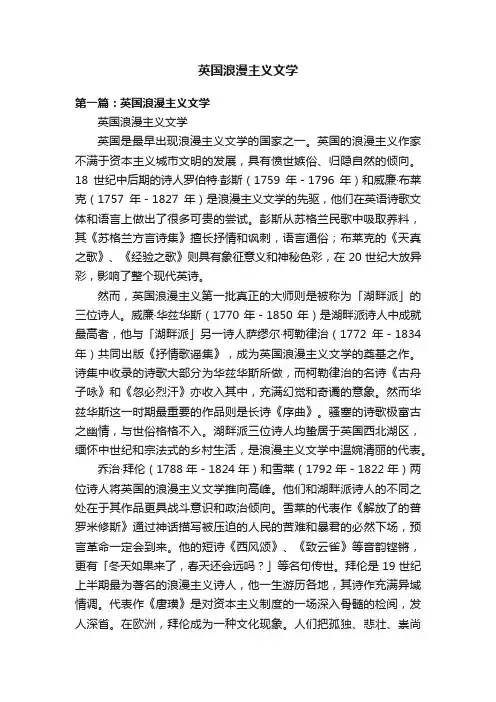
英国浪漫主义文学第一篇:英国浪漫主义文学英国浪漫主义文学英国是最早出现浪漫主义文学的国家之一。
英国的浪漫主义作家不满于资本主义城市文明的发展,具有愤世嫉俗、归隐自然的倾向。
18世纪中后期的诗人罗伯特·彭斯(1759年-1796年)和威廉·布莱克(1757年-1827年)是浪漫主义文学的先驱,他们在英语诗歌文体和语言上做出了很多可贵的尝试。
彭斯从苏格兰民歌中吸取养料,其《苏格兰方言诗集》擅长抒情和讽刺,语言通俗;布莱克的《天真之歌》、《经验之歌》则具有象征意义和神秘色彩,在20世纪大放异彩,影响了整个现代英诗。
然而,英国浪漫主义第一批真正的大师则是被称为「湖畔派」的三位诗人。
威廉·华兹华斯(1770年-1850年)是湖畔派诗人中成就最高者,他与「湖畔派」另一诗人萨缪尔·柯勒律治(1772年-1834年)共同出版《抒情歌谣集》,成为英国浪漫主义文学的奠基之作。
诗集中收录的诗歌大部分为华兹华斯所做,而柯勒律治的名诗《古舟子咏》和《忽必烈汗》亦收入其中,充满幻觉和奇谲的意象。
然而华兹华斯这一时期最重要的作品则是长诗《序曲》。
骚塞的诗歌极富古之幽情,与世俗格格不入。
湖畔派三位诗人均蛰居于英国西北湖区,缅怀中世纪和宗法式的乡村生活,是浪漫主义文学中温婉清丽的代表。
乔治·拜伦(1788年-1824年)和雪莱(1792年-1822年)两位诗人将英国的浪漫主义文学推向高峰。
他们和湖畔派诗人的不同之处在于其作品更具战斗意识和政治倾向。
雪莱的代表作《解放了的普罗米修斯》通过神话描写被压迫的人民的苦难和暴君的必然下场,预言革命一定会到来。
他的短诗《西风颂》、《致云雀》等音韵铿锵,更有「冬天如果来了,春天还会远吗?」等名句传世。
拜伦是19世纪上半期最为著名的浪漫主义诗人,他一生游历各地,其诗作充满异域情调。
代表作《唐璜》是对资本主义制度的一场深入骨髓的检阅,发人深省。
在欧洲,拜伦成为一种文化现象。
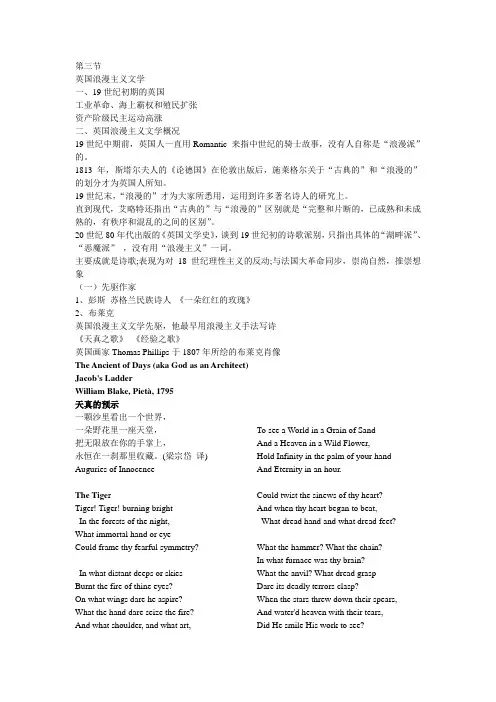
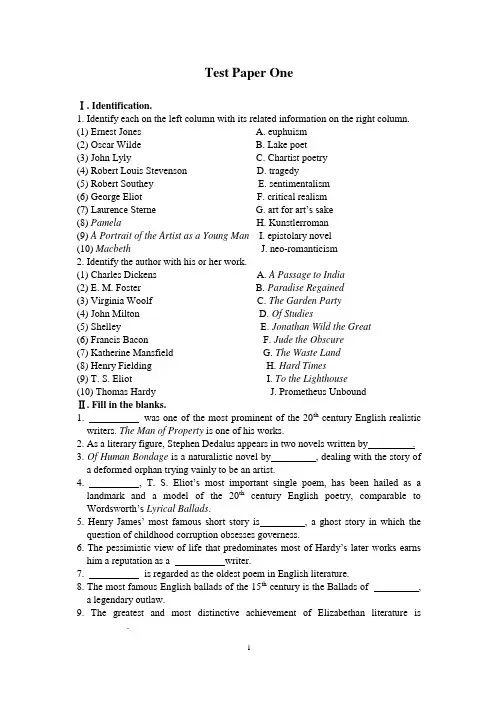
Test Paper OneⅠ. Identification.1. Identify each on the left column with its related information on the right column.(1) Ernest Jones A. euphuism(2) Oscar Wilde B. Lake poet(3) John Lyly C. Chartist poetry(4) Robert Louis Stevenson D. tragedy(5) Robert Southey E. sentimentalism(6) George Eliot F. critical realism(7) Laurence Sterne G. art for art’s sake(8) Pamela H. Kunstlerroman(9) A Portrait of the Artist as a Young Man I. epistolary novel(10) Macbeth J. neo-romanticism2. Identify the author with his or her work.(1) Charles Dickens A. A Passage to India(2) E. M. Foster B. Paradise Regained(3) Virginia Woolf C. The Garden Party(4) John Milton D. Of Studies(5) Shelley E. Jonathan Wild the Great(6) Francis Bacon F. Jude the Obscure(7) Katherine Mansfield G. The Waste Land(8) Henry Fielding H. Hard Times(9) T. S. Eliot I. To the Lighthouse(10) Thomas Hardy J. Prometheus UnboundⅡ. Fill in the blanks.1. was one of the most prominent of the 20th century English realistic writers. The Man of Property is one of his works.2. As a literary figure, Stephen Dedalus appears in two novels written by .3. Of Human Bondage is a naturalistic novel by , dealing with the story ofa deformed orphan trying vainly to be an artist.4. , T. S. Eliot’s most important single poem, has been hailed as a landmark and a model of the 20th century English poetry, comparable to Wordsworth’s Lyrical Ballads.5. Henry James’ most famous short story is , a ghost story in which the question of childhood corruption obsesses governess.6. The pessimistic view of life that p redominates most of Hardy’s later works earns him a reputation as a writer.7. is regarded as the oldest poem in English literature.8. The most famous English ballads of the 15th century is the Ballads of ,a legendary outlaw.9. The greatest and most distinctive achievement of Elizabethan literature is ________.10. and were two schools of poetry prevailing in the 17th century.11. wrote his famous prose composite on “An Essay of Dramatic Poesy” i n1668, which established his position as the leading critic of the day. 12. , one of Graham Green’s best novels, tells a story of the wandering of a whisky priest, an outlaw in Mexico, who is seedy and alcoholic as an ordinary man, but fulfills his function as priest.13. is Byron’s masterpiece, written in the prime of his creative power. He called it an “epic satire”, “a satire on abuses of the present state of society.”14. Romanticism was in effect a revolt of the English against the neoclassical , which prevailed from the days of Pope to those of Johnson.15. All such works of Coleridge as “The Rime of the Ancient Mariner”, “Christable” and “Kubla Khan” revealed his keen interest in.16. The Chartist writers introduced a new theme into English literature: the struggle of the for its rights.17. The Rape of the Lock takes the form of a , which describes the triviality of high society in a grand style.18. In , Jonathan Swift suggests that children of the poor Irish people be sold at one year old as food for the English nobles. It shows his indignation toward the terrible oppression and exploitation of the Irish people by the English ruling class.19. Horace Walpole’s novel began the tradition of Gothic romance in English literature.20. The typical feature of Robert Browning’s poetry is the .Ⅲ. Choose the best answer.1. Life of Charlotte Bronte is written by .A. Emily BronteB. Anne BronteC. Mrs. GaskellD. George Eliot2. was appointed poet laureate in succession to Wordsworth in1850.A. Alfred TennysonB. Robert BrowningC. Mrs. BrowningD. Dante Rossetti3. Most of Hardy’s novels are set in , the fictional primitive andcrude region which is really the home place he both loves and hates.A. LondonB. YoknapatawphaC. WessexD. Paris4. Which of the following novels doe s NOT belong to the “stream-of- consciousness” school of novel writing?A. UlyssesB. Finnegan’s WakeC. The RainbowD. The Waves5. is a story about the three generations of the Brangwen family on the Marsh farm.A. Sons and LoversB. Women in LoveC. The RainbowD. Man and Superman6. William Butler Yeats was .A. an Irish poetB. a dramatistC. a criticD. all of the above7. The hero in the romance is usually the .A. kingB. knightC. ChristD. churchman8. Which of the following statements is NOT true about the Elizabethan age?A. It is the age of intellectual liberty.B. It is the age of protestant reformation.C. It is the age of social contentment.D. It is the age of bourgeois revolution.9. The Pilgrim’s Progress is .A. a religious allegoryB. a dramatic sonnetC. a historical novelD. a long epic10. In his early volumes of poetry, mainly writes about animals which are emblems and analogues intended as comments on human life.A. Philip LarkinB. W. H. AudenC. Dylan ThomasD. Ted Hughes11. In The French Lieutenant’s Woman, is an existentially independent woman, as she said in the novel, “No limit, no blame, can touch me.”A. SarahB. ErnestinaC. MirandaD. Mantissa12. is distinctive in English literature because he makes thriller a serious form, and thus he bridges the gap between popular and serious writers.A. Graham GreeneB. George OrwellC. Evelyn WaughD. William Golding13. In , William Wordsworth set forth his prin ciples of poetry, “all good poetry is the spontaneous overflow of powerful feeling”.A. The Preface to Lyrical BalladsB. The Rime of the Ancient MarinerC. A Defence of PoetryD. Lectures on the English Poets14. The following statements are about “Childe Harold’s Pilgrimage”. Which statement is NOT true?A. It is about a young aristocrat whose “world-weariness” bespeaks his loathing forEnglish high society.B. Besides Harold’s impressions of the countries he visits, the poem is interspersedwith lyrical outbursts which give utterance to the poet’s own philosophical and political views.C. The first canto deals with Albania and Greece.D. The last canto sings of Italy and the Italian people who have given the worldgreat writers and thinkers like Dante.15. ’s poetry is always sensuous, colorful and rich in imagery, which expresses the acuteness of his senses. In his poetry, sight, sound, scent taste andfeeling are all taken into give an entire understanding of an experience.A. KeatsB. ShelleyC. WordsworthD. Byron16. Modern English novel, as a product of the 18th century Enlightenment and industrialization, really came with the rising of the class.A. workingB. aristocraticC. bourgeoisD. capitalist17. T. B. Smollett used the form of the novel in his books. This was later followed by Charles Dickens in The Pick wick Papers.A. epistolaryB. picaresqueC. GothicD. psychological18. wrote under the influence of Scottish folk tradition and old Scottish poetry.A. Jonathan SwiftB. Robert BurnsC. William BlakeD. Thomas Gray19. Which of the following is NOT from Ireland?A. Jonathan SwiftB. Alexander PopeC. Oliver GoldsmithD. Richard Brinsley Sheridan20. Which one is correct according to the time when they appeared?A. romanticism, neoclassicism, humanism, critical realismB. humanism, neoclassicism, romanticism, critical realismC. romanticism, humanism, realism, naturalismD. realism, critical realism, romanticism, humanismⅣ. Define the following terms.1. Parody2. Anti-novel3. Heroic couplet4. Blank verse5. Point of view6. Byronic hero7. Epistolarynovel edyofmannersⅤ. Short-answer questions.1. Please analyze Adam Bede to illustrate George Eliot’s moral view.2. What are the main features of the romance in the Middle Ages?3. Analyze the image of God in Paradise Lost.4. State briefly the artistic features of Jane Austen.5. What are the characteristics of William Blake’s poetry? Take “The Sick Rose” as an example.Ⅵ. Answer the questions according to the following passages.Passage 1I will arise and go now, and go to Innisfree,And a small cabin build there, of clay and wattles made:Nine bean-rows will I have there, a hive for the honey-bee,And live alone in the bee-loud glade.And I shall have some peace there, for peace comes dropping slow,Dropping from the veils of the mourning to where the cricket sings;There midnight’s all a glimmer, and noon a purple glow,And evening full of the linnet’s wings.I will arise and go now, for always night and dayI hear lake water lapping with low sounds by the shore;While I stand on the roadway, or on the pavements gray,I hear it in the deep heart’s core.Questions:1.Identify the author and the title of the poem.2.Why does the poet want to “arise and go”?3. Analyze the structure of this poem briefly.4. What is the theme of this poem?5. What are stylistic features of this poem?Passage2The spectral, half-compounded, aqueous light which pervaded the open mead impressed them with the feeling of isolation, as if they were Adam and Eve... It was then, as has been said, that she impressed him most deeply. She was no longer the milk maid, but a visionary essence of woman-a whole sex condensed into one typical form....Then it would grow lighter, and her features would becomes imply feminine; they had changed from those of a divinity who could confer bliss to those of a being who craved it.Questions:6. This is from Tess of the D’ Urbervilles, the section titled “The Rally” and Chapter XX. Who is “she” in this passage?7. What does this phrase “as if they were Adam and Eve” symbolize?8. How does the paragraph summarize the way that the man feels about the woman and how does this view of her influence the plot?Ⅶ. Essay question.Comment on D. H. Lawrence with reference to Sons and Lovers.KeysⅠ. Identification.1. Identify each on the left column with the related information on the right column. (1) C (2) G (3) A (4) J (5) B(6) F (7) E (8) I (9) H (10) D2. Identify the author with his or her work.(1) H (2) A (3) I (4) B (5) J(6) D (7) C (8) E (9) G (10) FⅡ. Fill in the blanks.1. John Galswathy2. James Joyce3. William Somerset Maugham4. The Waste Land5. The Turn of the Screw6. naturalistic7. Beowulf 8. Robin Hood9. drama 10. Metaphysical Poetry; Cavalier Poetry 11. John Dryden 12. The Power and the Glory13. Don Juan14. Imagination; reason15. mysticism 16. proletariat17. mock epic 18. A Modest Proposal19. The Castle of Otranto20. dramatic monologueⅢ. Choose the best answer.1. C2. A3. C4. C5. C6. D7. B8. D9. A 10. D11. A 12. A 13. A 14. C 15. A16. C 17. B 18. B 19. B 20. BⅣ. Define the following terms.1. Parody: A parody is a high burlesque. It imitates the serious manner and characteristic features of a particular literary work, or the distinctive style of a particular author, or the typical stylistic and other features of a serious literary genre, and deflates the original by applying the imitation to a lowly or comically inappropriate subject. Henry Fielding in Joseph Andrews parodied Samuel Richardson’s Pamela by putting a hearty male heroin place of Richardson’s heroine.2. Anti-novel: A form of experimental fiction that dispenses with certain traditional elements of novel-writing like the analysis of characters’ states of mind or the unfolding of a sequential plot. Antecedents of the anti-novel can be found in the blank pages and comically self-defeating digressions of Sterne’s Tristram Shandy (1759~1767) and in some of the innovations of modernism, like the absence of narration in Virginia Woolf’s The Waves (1931).3. Heroic couplet: Iambic pentameter lines rhyming in pairs are called decasyllabic (ten-syllable) couplets or heroic couplets.4. Blank verse:Blank verse was first introduced by the Earl of Surrey in his translations of Books 2 and 4of Virgil’s The Aeneid. It consists of lines of iambic pentameter (five-stress iambic verse) which are unrhymed—hence the term “blank”. Of all English metrical forms it is closest to the natural rhythms of English speech, and at the same time flexible and adaptive to diverse levels of discourse; as a result it has been more frequently and variously used than any other type of versification. It became the standard meter for Elizabethan and later poetic drama; a free form of blank verse is still the medium in twentieth-century verse plays.5. Point of view: The vantage point from which a narrative is told. There are two basic points of view: first-person and third-person.(1) In the first-person point of view, the story is told by one of the characters in hisor her own word. The first-person point of view is limited, since the reader is told only what this character knows and observes.(2) In the third person point of view, the narrator is not a character in the story .Thenarrator may be an “omniscient” or “all-knowing” observer who can describe and comment on all the characters and actions in the story. On the other hand, the third-person narrator might tell a story from the point of view of only one character in the story.6. Byronic hero:A stereotyped character created by Byron. This kind of hero is usually a proud, mysterious rebel figure of noble origin. With immense superiority in his passions and powers, he would carry on his shoulders the burden of right in gall the wrongs in a corrupt society. He would rise single-handedly against any kind of tyrannical rules either in government, in religion, or in moral principles with unconquerable wills and inexhaustible energies. The conflict is usually one of rebellious individuals against outworn social systems and conventions.7. Epistolary novel: A type of novel in which the narrative is carried on by means of series of letters. The genre was extremely popular during the 18th century. Samuel Richardson’s Pamela is among the best-known epistolary novels.8. Comedy of manners: A kind of comedy representing the complex and sophisticated code of behavior current in fashionable circles of society, where appearances count for more than true moral character. Its humor relies chiefly on elegant verbal wit and repartee. In England, the comedy of manners flourished as the dominant form of Restoration comedy in the works of Etheredge, Wycherley and Congreve. It was revived in a more subdued form in the 1770s by Goldsmith and Sheridan, and later by Oscar Wilde.Ⅴ. Short-answer questions.1. As a philosopher turned novelist, Eliot wrote her novels with the aim o f propagating her moral views. Adam Bede is a novel of moral conflicts, showing the contest of personal desires, passion, temperament, human weaknesses and the claims of moral duty. The theme of social in equality is blended in the book with a moralization typical of the author. In the novel, the two pairs, Arthur and Hetty on the one hand, and Adam and Dinah on the other, are described in contrast to each other. The former couple are shown to be always thinking of their own interests without any consideration of others, while the latter pair are endowed with high moral principles which guide their conduct for the good of others and of themselves. The novelist takes her side with the latter party. According to Eliot, the moral principles of man are closely c onnected with the “religion of heart”. This shows theinfluence of the bourgeois positivist philosophy which seeks to reconcile science with religion and to prove the possibility of social harmony and concord in a capitalist society.2. The romance was the prevailing form of literature in the Middle Ages. Its essential features are:(1) It lacks general resemblance to truth or reality.(2) It exaggerates the vices of human nature and idealizes the virtues.(3) It contains perilous adventures more or less remote from ordinary life.(4) It lays emphasis on supreme devotion to a fair lady.(5) The central character of the romance is the knight, a man of noble birth skilledin the use of weapons. He is commonly described as riding forth to seek adventures, taking part in tournaments, or fighting for his lord in battle. He is devoted to the church and the king.3. In the poem God is no better than a selfish despot, seated upon a throne with a chorus of angels about him eternally singing his praises. His long speeches are never pleasing. He is cruel and unjust in his struggle against Satan.4. (1) Jane Austen’s main concern is about human beings in their personal relations,human beings with their families and neighbors. She is particularly preoccupied with the relationship between men and women in love.(2) She writes with in a narrow sphere. The subject matter, the character range, themoral setting, physical setting and social setting, and plots are all restricted to the provincial or village life of the 19th-century England, all concerning three or four landed gentry families with the trivial incidents of their everyday life. (3) Her novels are surprisingly realistic, with keen observation and penetratinganalysis. She keeps the balance between fact and form as no other English novelist has ever done.(4) Austen uses dialogues to reveal the personalities of her characters. The plots ofher novels appear natural and unforced. Her characters are vividly portrayed and everyone comes alive.(5) Her language, which is of typical neoclassicism, is simple, easy, naturally lucidand very economical.5. Blake writes his poems in plain and direct language. His poems often carry the lyric beauty with immense compression of meaning. He distrusts the abstractness and tends to present his view with visual images instead of abstract terms. Symbolism in wide range is also a distinctive feature of his poetry.In “The Sick Rose”, the poet is looking at a blighted rose. He is moved to reflect on some kind of curious relationship between love and death. The poem is brief and on the surface the language is simple and lucid. Beneath the poem is a profound vision of good and evil, of life-bringing and death-bringing love, of brightness and darkness, of forces we can know little about, of motives that are hard to fathom.Ⅵ. Answer the questions according to the following passages.Passage 11. William Butler Yeats’ “The Lake Isle Of Innisfree”.2. “While I stand on the roadway, or on the pavements gray”, which is a typical image of city dwe lling, the poet finds that he doesn’t feel good in urban surroundings and is tired of the life of his day, and he hears in his heart “lake water lapping with low sounds by the shore”, so he wants to “arise and go” to escape into an ideal “fairyland” where he could live calmly as a hermit and enjoy the beauty of the nature.3. The poem consists of three quatrains of iambic pentameter, with each stanza rhymed abab.4. The poem is one of the poet’s best-known lyrics and a popular representative of the poems which get meaning by contrasting ideas or images like human and fairy, natural and artificial, domestic and wild, and ephemeral and permanent. Tired of the life of his day, the poets ought to escape into an ideal “fairyland” where he could live calmly as a hermit and enjoy the beauty of the nature. From his viewpoint, the best remedy for the blankness of his life seems to be a return to simple and serene life of the past.5. The poem is closely woven, easy, subtle and musical. The clarity and control of the imagery give the poem a hunting quality.Passage 26. Tess of the D’s Urbervilles, or “Tess” is an acceptable answer.7. It symbolizes their innocence or perhaps the idea that they see each other, especially Angel sees Tess, as perfect.8. Angel basically sees Tess as a pure, innocent representative of the whole race, not as a real person. He idealizes her too much and does not allow for her to be an actual human with weaknesses. Later, he deserts her when he realizes that she has been with another man already—she is not the perfect person he had imagined so he leaves her. Grading notes: to get all the points the student must mention the fact that Angel sees Tess as more perfect than she is, that he is disappointed in some way by this, and that he leaves h er later when he realizes that she isn’t perfect/innocent.Ⅶ. Essay question.D. H. Lawrence is one of the greatest English novelists of the 20th century. He makes a strong protest against the mechanical civilization. It is this agonized concern about the dehumanizing effect of mechanical civilization on the sensual tenderness of human nature that haunts Lawrence’s writing. He holds that the only remedy to the decaying civilization is through are arrangement of personal relationships and are turn to nature .In his writings, he is chiefly concerned with human relationships, especially with the relation of self to other selves. From his viewpoint, the most important relationship is the one between man and woman, which should develop freely and healthily. Lawrence is one of the first novelists to introduce themes of ps ychology into his works. Lawrence’s artistic tendency is mainly realism, which combines dramatic scenes with an authoritative commentary. Through a combination of traditional realism and the innovating elements of symbolism and poetic imagination, Lawrence has managed to depict the subtle ebb and flow of his characters’ subconscious life.All these features of D. H. Lawrence are reflected in his autobiographical novel Sons and Lovers thematically, sociologically and psychologically. Lawrence was from a working-class family. His father was a miner with little education, thus his mother, a school teacher, thought she had married beneath her and was eager to raise the level of her sons. His mother’s claims on him kept frustrating his relationships with girls, and personal problems and conflicts that resulted are vividly presented in this novel.Sons and Lovers displays Lawrence’s characteristic themes: the dehumanizing effect of the bourgeois industrialization; the complexity of human relationship; the emotional possession; and the spiritual liberation of the protagonist in search for identity and fulfillment as an artist. The psychic conflict in human relationships is the central theme. Sociologically, Sons and Lovers is a novel about the “sickness of a whole ci vilization” that causes the destruction of human nature. Psychologically, the novel depicts a triangle of father, mother and son, which embodies Freud’s remarkable psychosexual theory.。

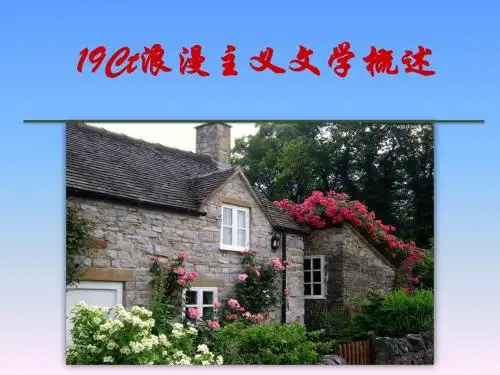
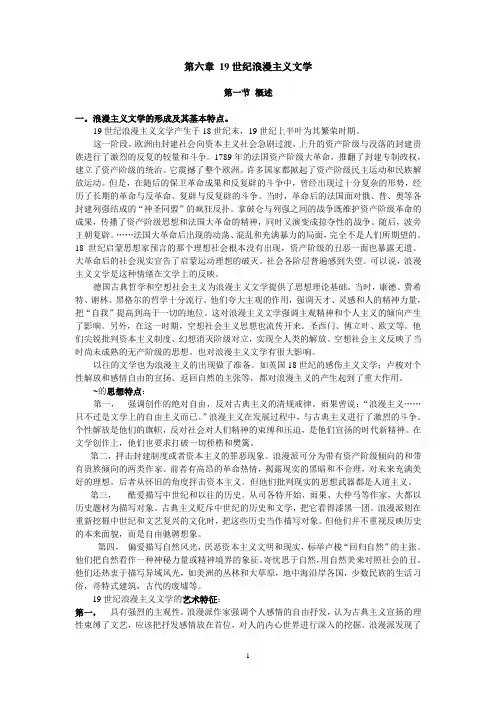
第六章19世纪浪漫主义文学第一节概述一。
浪漫主义文学的形成及其基本特点。
19世纪浪漫主义文学产生于18世纪末,19世纪上半叶为其繁荣时期。
这一阶段,欧洲由封建社会向资本主义社会急剧过渡,上升的资产阶级与没落的封建贵族进行了激烈的反复的较量和斗争。
1789年的法国资产阶级大革命,推翻了封建专制政权,建立了资产阶级的统治。
它震撼了整个欧洲。
许多国家都掀起了资产阶级民主运动和民族解放运动。
但是,在随后的保卫革命成果和反复辟的斗争中,曾经出现过十分复杂的形势,经历了长期的革命与反革命、复辟与反复辟的斗争。
当时,革命后的法国面对俄、普、奥等各封建列强结成的“神圣同盟”的疯狂反扑。
拿破仑与列强之间的战争既维护资产阶级革命的成果,传播了资产阶级思想和法国大革命的精神,同时又演变成掠夺性的战争。
随后,波旁王朝复辟。
……法国大革命后出现的动荡、混乱和充满暴力的局面,完全不是人们所期望的。
18世纪启蒙思想家预言的那个理想社会根本没有出现,资产阶级的丑恶一面也暴露无遗。
大革命后的社会现实宣告了启蒙运动理想的破灭。
社会各阶层普遍感到失望。
可以说,浪漫主义文学是这种情绪在文学上的反映。
德国古典哲学和空想社会主义为浪漫主义文学提供了思想理论基础。
当时,康德、费希特、谢林、黑格尔的哲学十分流行。
他们夸大主观的作用,强调天才、灵感和人的精神力量,把“自我”提高到高于一切的地位。
这对浪漫主义文学强调主观精神和个人主义的倾向产生了影响。
另外,在这一时期,空想社会主义思想也流传开来。
圣西门、傅立叶、欧文等。
他们尖锐批判资本主义制度、幻想消灭阶级对立,实现全人类的解放。
空想社会主义反映了当时尚未成熟的无产阶级的思想。
也对浪漫主义文学有很大影响。
以往的文学也为浪漫主义的出现做了准备。
如英国18世纪的感伤主义文学;卢梭对个性解放和感情自由的宣扬、返回自然的主张等,都对浪漫主义的产生起到了重大作用。
~的思想特点:第一,强调创作的绝对自由,反对古典主义的清规戒律。

英国文学:浪漫主义时期(romanticsm)18世纪末和19世纪出浪漫主义文学在全欧盛行。
浪漫主义作家反映了那一时期处在资产阶级革命和社会革命时期的社会情绪、意识形态及人生观。
他们注重人的本能和感情,以此表达对社会现实的不满。
浪漫主义文学与古典主义的灵感的想像,思想与情感,尤其主张以诗歌来抒发个人的情感,表达对理想的追求。
英国诗人威廉.布莱克和罗伯特.彭斯开创了浪漫主义诗歌的先河,到了19世纪上半叶,英国的浪漫主义诗歌达到顶峰。
由于诗人的社会立场和作品的思想内涵不尽相同,19世纪前期英国浪漫主义可分为消极和积极两个派别。
以威廉.华兹华斯、柯尔律治、骚塞等“湖畔诗人”为代表的消极浪漫主义诗人愤世嫉俗,忧郁失望,作品以诗吟湖光山色和田园风光为主。
以拜伦、雪莱、济慈等为代表的积极浪漫主义诗人则充满破除封建束缚的革命激情和向往新生活的崇高理想。
作品强调自由平等和个性解放,充满瑰丽的想像和奔放的激情。
威廉.布莱克的《天真之歌》展现了一个充满博爱、仁慈、怜悯和快乐的世界。
诗人用孩子般的眼光看世界,用空想欢乐主义来理解社会。
鲜明有力的诗句中处处渗透出诗人对生活与自然的孩子般率真而欣悦的感受以及对宇宙和谐的领悟。
在《经验之歌》创作与刻印期间,诗人的思想受到法国革命的巨大冲击,对革命寄予了深切的同情。
诗人清楚地理解了英国人民的苦难,不再天真,对社会有了深刻的经验。
布莱克的其他作品与以上诗集风格有所不同。
形式上,他放弃了惯用的格律而采用无韵的自由体诗,内容上,他以歌颂人性解放与精神自由、歌颂革命、反对传统的理性主义以及英国封建专制以及追求崇高而神圣的理想为主。
《耶路撒冷》一诗长四千多行,主要讲了人的堕落与重生。
布莱克诗中的人道主义与民主主义精神赋予了诗歌极大的生命力;艺术上打破了18世纪古典主义的清规戒律。
他强调本能、感情、想像力,以清新奔放的无韵体诗抒发理想。
布莱克给诗坛带来的一股清新奇特的诗风对后浪漫主义的发展有着功不可没的贡献,是浪漫主义诗歌的先驱。
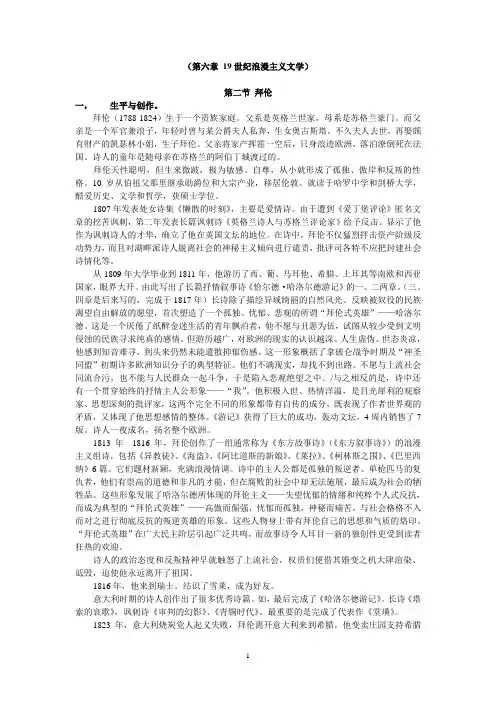
(第六章19世纪浪漫主义文学)第二节拜伦一,生平与创作。
拜伦(1788-1824)生于一个贵族家庭。
父系是英格兰世家,母系是苏格兰豪门。
而父亲是一个军官兼浪子,年轻时曾与某公爵夫人私奔,生女奥古斯塔。
不久夫人去世,再娶颇有财产的凯瑟林小姐,生子拜伦。
父亲将家产挥霍一空后,只身浪迹欧洲,落泊潦倒死在法国。
诗人的童年是随母亲在苏格兰的阿伯丁城渡过的。
拜伦天性聪明,但生来微跛,极为敏感、自尊,从小就形成了孤独、傲岸和反叛的性格。
10岁从伯祖父那里继承勋爵位和大宗产业,移居伦敦。
就读于哈罗中学和剑桥大学,酷爱历史、文学和哲学,获硕士学位。
1807年发表处女诗集《懒散的时刻》,主要是爱情诗。
由于遭到《爱丁堡评论》匿名文章的挖苦讽刺,第二年发表长篇讽刺诗《英格兰诗人与苏格兰评论家》给予反击。
显示了他作为讽刺诗人的才华,确立了他在英国文坛的地位。
在诗中,拜伦不仅猛烈抨击资产阶级反动势力,而且对湖畔派诗人脱离社会的神秘主义倾向进行谴责,批评司各特不应把封建社会诗情化等。
从1809年大学毕业到1811年,他游历了西、葡、马耳他、希腊、土耳其等南欧和西亚国家,眼界大开。
由此写出了长篇抒情叙事诗《恰尔德·哈洛尔德游记》的一、二两章。
(三、四章是后来写的,完成于1817年)长诗除了描绘异域绮丽的自然风光、反映被奴役的民族渴望自由解放的愿望,首次塑造了一个孤独、忧郁、悲观的所谓“拜伦式英雄”——哈洛尔德。
这是一个厌倦了纸醉金迷生活的青年飘泊者,他不愿与丑恶为伍,试图从较少受到文明侵蚀的民族寻求纯真的感情。
但游历越广,对欧洲的现实的认识越深。
人生虚伪、世态炎凉,他感到知音难寻,到头来仍然未能遣散抑郁伤感。
这一形象概括了拿破仑战争时期及“神圣同盟”初期许多欧洲知识分子的典型特征。
他们不满现实,却找不到出路。
不愿与上流社会同流合污,也不能与人民群众一起斗争,于是陷入悲观绝望之中。
/与之相反的是,诗中还有一个贯穿始终的抒情主人公形象——“我”。
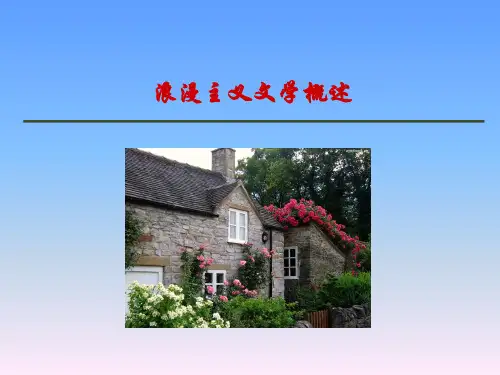
-----------------------------------------------------英国---------------------------------------华兹华斯、P173英国浪漫主义文学先驱华兹华斯(William Wordsworth,1770-1850),英国诗人,华兹华斯生于律师之家,1783年他的父亲去世,他和弟兄们由舅父照管,妹妹多萝西(Dorothy)则由外祖父母抚养。
多萝西与他最为亲近,终身未嫁,一直与他作伴。
拜伦;P179乔治·戈登·拜伦(1788—1824),是英国19世纪初期伟大的浪漫主义诗人。
其代表作品有《恰尔德·哈罗德游记》、《唐璜》等。
在他的诗歌里塑造了一批“拜伦式英雄”。
拜伦不仅是一位伟大的诗人,还是一个为理想战斗一生的勇士;他积极而勇敢地投身革命,参加了希腊民族解放运动,并成为领导人之一。
P181被逼离开英国,认识了雪莱,成为知音拜伦式英雄P180在拜伦的《东方叙事诗》中,出现了一批侠骨柔肠的硬汉,他们有海盗、异教徒、被放逐者,这些大都是高傲、孤独、倔强的叛逆者,他们与罪恶社会势不两立,孤军奋战与命运抗争,追求自由,最后总是以失败告终。
拜伦通过他们的斗争表现出对社会不妥协的反抗精神,同时反映出自己的忧郁、孤独和彷徨的苦闷。
这些就是文学史上著名的“拜伦式英雄”。
由于这些形象具有作者本人的思想性格特征,因此被称作“拜伦式英雄”。
"拜伦式英雄"是指十九世纪英国浪漫主义诗人拜伦作品中的一类人物形象。
他们高傲倔强,既不满现实,要求奋起反抗,具有叛逆的性格;但同时又显得忧郁、孤独、悲观,脱离群众,我行我素,始终找不到正确的出路。
例如,抒情长诗《恰尔德·哈洛尔德游记》中贵公子哈洛尔德,《东方叙事诗》之一《海盗》(*The Corsair, 1814)中的主人公康拉德,哲理剧《曼弗雷德》中的主人公曼弗雷德,等等。